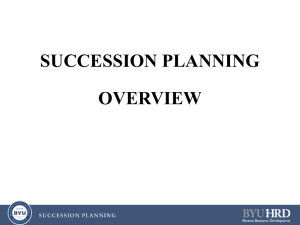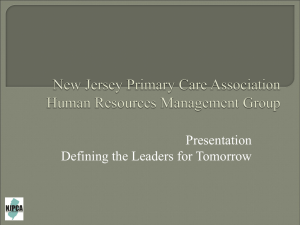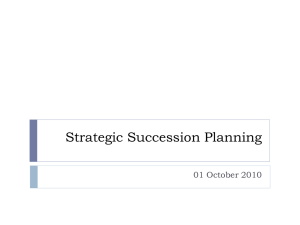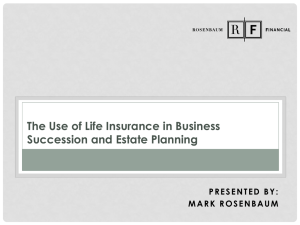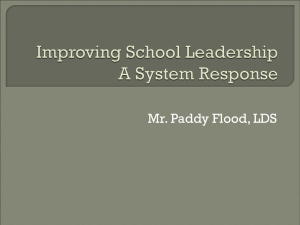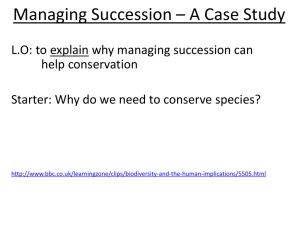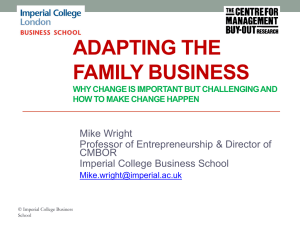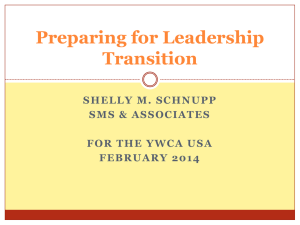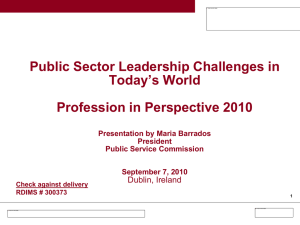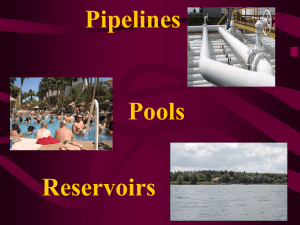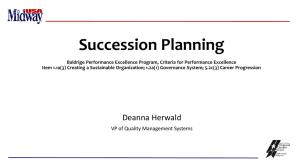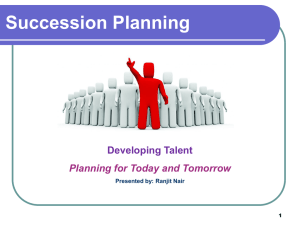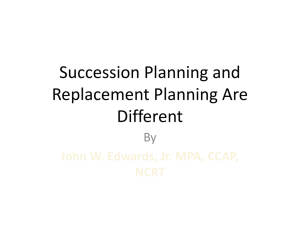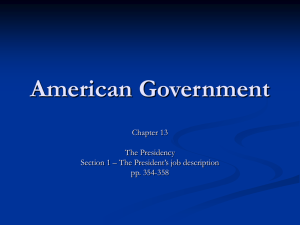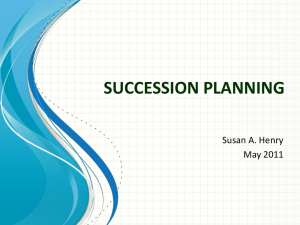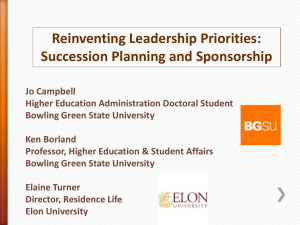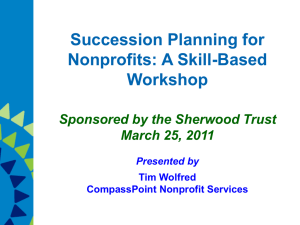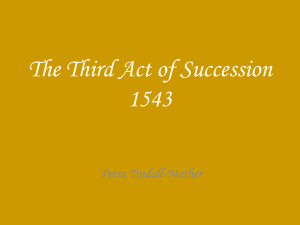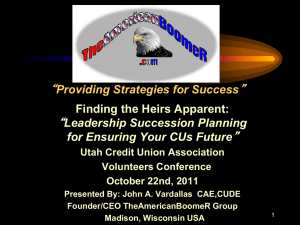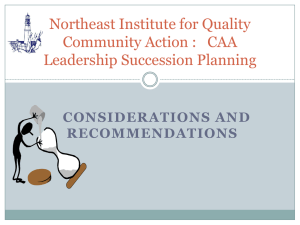Leadership Development and Succession Planning
advertisement
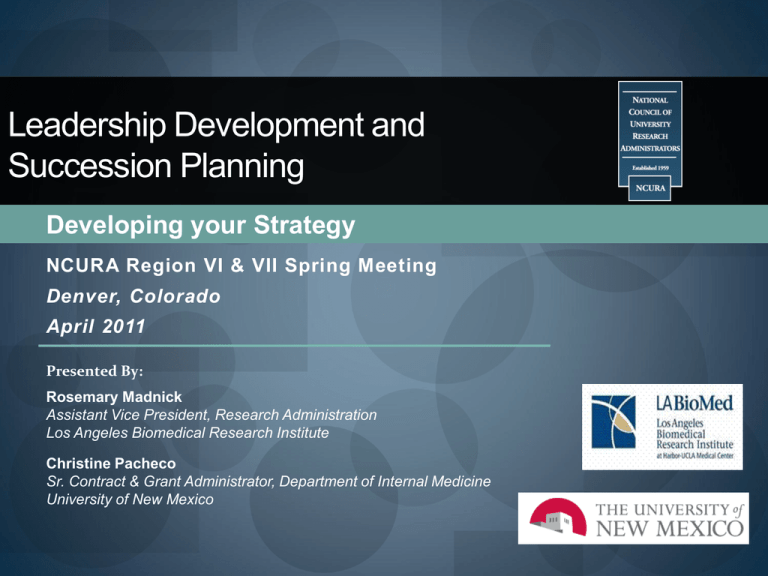
Leadership Development and Succession Planning Developing your Strategy NCURA Region VI & VII Spring Meeting Denver, Colorado April 2011 Presented By: Rosemary Madnick Assistant Vice President, Research Administration Los Angeles Biomedical Research Institute Christine Pacheco Sr. Contract & Grant Administrator, Department of Internal Medicine University of New Mexico “We put good people in big jobs before they are ready”. Pepsi Co What is succession planning? Systematic process for identifying, assessing and developing staff Vital to future success of an organization Strategic Planning for Human Capital Investment in your future leaders Succession Planning is proactive and not reactive Sustainability that creates motivated and capable employees Key Issues: Support and backing of Senior Management Part of integrated HR process Identify skills needed by the organization Critical positions must be identified and included in the planning Identify high performers Identify soon to be retirees Identify skills, responsibilities and competencies Establish a system of communication Leadership Development = V+C+L Variety of Experiences + Challenging Assignments + Ability & Willingness to Learn Center for Creative Leadership Succession Planning: Key Elements Assessment of Key Positions Development Monitoring & Review Identification of Key Talent Key Elements Assessment of Key Talent Generation of Development Plans Succession Planning: Key Elements Assessment of Key Positions Identification of Key Talent Assessment of Key Talent Generation of Development Plans Development of Monitoring & Review SUCCESSION CANDIDATES KEY POSITION TITLE ________________________ Backup Candidate Name: ______________________ Current Title: ________________________________ Div: ______________ Level of Readiness (Circle One): Within 1 Yr. 1–3 Yrs. 3–5 Yrs. __________________________________________________ Strengths for this position: Developmental needs for this position: Comments: __________________________________________________ Date: FY: Completed by: Division: SUCCESSION PLAN SUMMARY ORGANIZATION:_____________________ Key Position Title Incumbent Name Position Succession Candidate Vulnerability Names Open in Open in Open in Ready in Ready in Ready in < 1 Yr 1–3 Yrs 3 + Yrs < 1 Yr 1–3 Yrs 3 + Yrs EXECUTIVE DEVELOPMENT PLAN NAME: ________________ 2. Special Assignment: (What task force, projects, or special assignments will be given this year to aid development?) TITLE: ________________ Overall Performance Summary: (Indicate recent performance including major accomplishments or performance issues.) Key Strengths: (List 2 - 3. Indicate key technical or professional competencies, skills, or knowledge the person has.) Development Needs: (List 2 or 3. Indicate key experiences, skills, or knowledge the person lacks in order to move to the next level.) 3. Training: (What specific training or seminars are recommended this year for his/her development?) Potential For Promotion: (Indicate this persons readiness to be promoted to the next organizational level.) Ready now for the next level. Ready in the next 24 months. Ready in 2 to 3 years. Development Actions: 1. On The Job: (What new responsibilities do you plan to assign to help this person develop this year?) Recommended Next Position: (List the next assignment that would most benefit the individual in his/her development.) Development Toolbox Highest Return… Full Job Change Focused On Development Needs Job Restructuring Based On Development Needs Mini Assignments Cross Divisional Project Leadership Or Assignment Focused Coaching & Counseling Industry Representation Industry Representation Visits Accompanying Senior Executives Formalized Education Programs Full 360 Degree Feedback and Evaluation Motivated Self Development Seminars and Conferences … Lowest Return Toolbox for Succession Development On the Job: Job Enrichment Special Projects Committee Assignments Task Force Participation Giving Presentations Leading a New Project Temporary Job Assignments Full Job Change Toolbox for Succession Development Learning From Others: Working with a Mentor Teaming with an Expert 360 Feedback Focused Interviews Training & Education Seminars and Conferences Continuing Education Cross Training Semi-Annual Succession Planning Review Review of succession candidates and development plans in each organizational unit/area Report development progress and make necessary adjustments to the plan Orchestrate moves for the next 6 months Pitfalls of Succession Planning Underestimating or overlooking employees Not considering lateral moves Not offering training and development opportunities Not tailoring a developmental plan specifically to the position Not holding managers and leaders accountable Not sharing the data with employees "The domain of leaders is the future. The leader's unique legacy is the creation of valued institutions that survive over time. The most significant contribution leaders make is not simply to today's bottom line; it is to the longterm development of people and institutions so they can adapt, change, prosper, and grow." Source: The Leadership Challenge, Kouzes & Posner (4th ed. 2007) Contact Information Rosemary Madnick Assistant Vice President, Research Administration Los Angeles Biomedical Research Institute 1124 West Carson Street Torrance, CA 90502 310-222-3621 rmadnick@labiomed.org Christine Pacheco Department of Internal Medicine MSC10 5550 1 University of New Mexico Albuquerque, NM 87131-0001 505-272-6330 cppacheco@salud.unm.edu QUESTIONS THANK YOU
